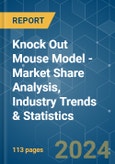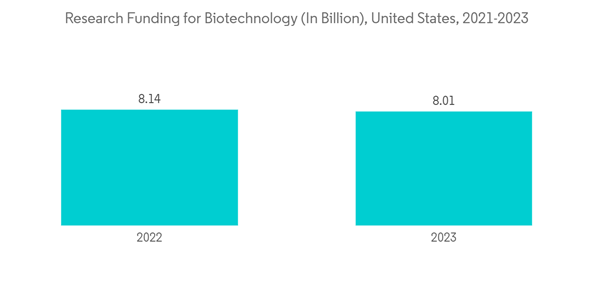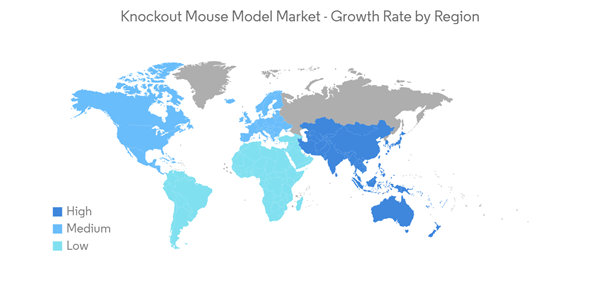The Knock Out Mouse Model Market size is estimated at USD 1.37 billion in 2024, and is expected to reach USD 1.79 billion by 2029, growing at a CAGR of 5.20% during the forecast period (2024-2029).
During the COVID-19 pandemic, the knockout mouse model market was significantly impacted due to the wide usage of these models in COVID-19-related studies. Furthermore, the continued studies on COVID-19 in laboratories using the knockout mouse model are expected to continue growth over the coming period. For instance, as per the report published by eBioMedicine in December 2021, the suppression of NLRP3 inflammasome by genetic knockout and specific inhibitors in the mouse models consistently displayed its immune importance in COVID-19 disease progression. It showed the importance of the knockout mouse model in COVID-19 research, which is expected to boost the market over the coming years.
Factors driving the knockout mouse model market growth include the increasing development of novel and innovative drugs and medical devices, rising demand for personalized medicine, and advancements in gene editing tools. Additionally, the knockout mouse model market is expanding with increased R&D activities in pharmaceutical industries. For instance, in May 2021, Taysha Gene Therapies, Inc. published new preclinical data for TSHA-102 in Rett syndrome. TSHA-102 resulted in a statistically significant survival extension by 56% in 4-5-week-old knockout Rett mice with meaningful accumulated disease. In contrast, unregulated constructs did not extend survival significantly in the validated MECP2 knockout Rett mouse model. It shows the wide usage of knockout mouse models in various research studies.
For instance, as per the report published by Cyagen Biosciences in April 2021, the knockout mouse model is a crucial resource for drug development. To greatly increase pertinent insights into innovative diagnostic and therapeutic methods, heterozygous and homozygous knockout lines are frequently used in human disease research, such as for investigations of rare diseases and developmental disorders. These widespread applications of knockout mouse models in the pharmaceutical industry are expected to include significant growth in the market over the forecast period.
The strategic activities by the market players is expected to boost the market over the forecast period. For instance, in October 2022, Taconic Biosciences launched the FcResolv NOG portfolio, the super immunodeficient mouse model with a knockout of murine Fc gamma receptors (FcγRs). It is known to confound results in antibody-based therapy studies. Additionally, in August 2022, the University of California, Davis, awarded just over USD 12 million from the NIH under the third and final five-year phase of the Knockout Mouse Phenotyping Project, or KOMP2. This final phase of KOMP2 aims to produce and phenotype hundreds of knockout mouse models for genes with little to no known function to better understand the genetic bases for diseases in humans and animals.
However, alternatives to animal testing and regulations for the ethical use of animals are the major factors restraining the growth of the knockout mouse model market over the forecast period.
For instance, as per the report published by Cyagen Biosciences in April 2021, conditional models offer greater temporal and regional control of gene expression than constitutively expressed gene mutations, making them a more accurate model for researching human diseases. It shows the added advantages of conditional models over other models, which increases the usage of these models and is expected to boost the growth of the segment in the market.
Furthermore, the increasing usage of conditional knockout mouse models in research and development is expected to drive the market. For instance, as per the study report published by iScience in July 2021, conditional knockout (cKO) of Celsr3 in postnatal Purkinje cells of mice exhibited a deficit in motor coordination and learning, atrophic Purkinje cell dendrites, and decreased synapses. Using Celsr3-GFP mice, Celsr3 shows high expression in postnatal Purkinje cells. These studies help in various types of research, which likely propel the market over the study period.
For instance, in July 2022, Tenaya Therapeutics, Inc. published the preclinical research data in Science Translational Medicine detailing the discovery of HDAC6 inhibitors as cardioprotective in a BAG3 mouse model of dilated cardiomyopathy. To further validate the potential of HDAC6 inhibition, Tenaya translated its initial in vitro findings to a BAG3 cardiomyocyte knockout mouse model of dilated cardiomyopathy. It shows the new application of the knockout mouse model, which increases the usage of the model and is expected to boost the market over the forecast period.
Similarly, the approval of these models for clinical development is expected to drive the market. For instance, in March 2022, Taysha Gene Therapies, Inc. initiated the clinical development of TSHA-102 for treating Rett syndrome under an approved Clinical Trial Application (CTA) by Health Canada. The pharmacologic activity of TSHA-102 following intrathecal (IT) administration was assessed in the MECP2 knockout mouse model of Rett syndrome across three dose levels and three age groups. Thus, these models' new research activities and approvals are expected to boost market growth over the forecast period.
This product will be delivered within 2 business days.
During the COVID-19 pandemic, the knockout mouse model market was significantly impacted due to the wide usage of these models in COVID-19-related studies. Furthermore, the continued studies on COVID-19 in laboratories using the knockout mouse model are expected to continue growth over the coming period. For instance, as per the report published by eBioMedicine in December 2021, the suppression of NLRP3 inflammasome by genetic knockout and specific inhibitors in the mouse models consistently displayed its immune importance in COVID-19 disease progression. It showed the importance of the knockout mouse model in COVID-19 research, which is expected to boost the market over the coming years.
Factors driving the knockout mouse model market growth include the increasing development of novel and innovative drugs and medical devices, rising demand for personalized medicine, and advancements in gene editing tools. Additionally, the knockout mouse model market is expanding with increased R&D activities in pharmaceutical industries. For instance, in May 2021, Taysha Gene Therapies, Inc. published new preclinical data for TSHA-102 in Rett syndrome. TSHA-102 resulted in a statistically significant survival extension by 56% in 4-5-week-old knockout Rett mice with meaningful accumulated disease. In contrast, unregulated constructs did not extend survival significantly in the validated MECP2 knockout Rett mouse model. It shows the wide usage of knockout mouse models in various research studies.
For instance, as per the report published by Cyagen Biosciences in April 2021, the knockout mouse model is a crucial resource for drug development. To greatly increase pertinent insights into innovative diagnostic and therapeutic methods, heterozygous and homozygous knockout lines are frequently used in human disease research, such as for investigations of rare diseases and developmental disorders. These widespread applications of knockout mouse models in the pharmaceutical industry are expected to include significant growth in the market over the forecast period.
The strategic activities by the market players is expected to boost the market over the forecast period. For instance, in October 2022, Taconic Biosciences launched the FcResolv NOG portfolio, the super immunodeficient mouse model with a knockout of murine Fc gamma receptors (FcγRs). It is known to confound results in antibody-based therapy studies. Additionally, in August 2022, the University of California, Davis, awarded just over USD 12 million from the NIH under the third and final five-year phase of the Knockout Mouse Phenotyping Project, or KOMP2. This final phase of KOMP2 aims to produce and phenotype hundreds of knockout mouse models for genes with little to no known function to better understand the genetic bases for diseases in humans and animals.
However, alternatives to animal testing and regulations for the ethical use of animals are the major factors restraining the growth of the knockout mouse model market over the forecast period.
Knock Out Mouse Model Market Trends
Conditional Knockout Mouse Segment is Expected to Hold Significant Share in the Market Over the Forecast Period
In conditional knockout mice, a gene is inactivated in a specific tissue to study the function of individual genes and model human diseases. Due to the various advantages of conditional knockout mouse models over other models, the segment is expected to include significant growth in the market. The rising pharmaceutical investment and expenditure and strategic initiatives adopted by the market players are augmenting the demand for conditional knockout mouse models, contributing to the market growth.For instance, as per the report published by Cyagen Biosciences in April 2021, conditional models offer greater temporal and regional control of gene expression than constitutively expressed gene mutations, making them a more accurate model for researching human diseases. It shows the added advantages of conditional models over other models, which increases the usage of these models and is expected to boost the growth of the segment in the market.
Furthermore, the increasing usage of conditional knockout mouse models in research and development is expected to drive the market. For instance, as per the study report published by iScience in July 2021, conditional knockout (cKO) of Celsr3 in postnatal Purkinje cells of mice exhibited a deficit in motor coordination and learning, atrophic Purkinje cell dendrites, and decreased synapses. Using Celsr3-GFP mice, Celsr3 shows high expression in postnatal Purkinje cells. These studies help in various types of research, which likely propel the market over the study period.
North America is Expected to include Significant Share in Market Over the Forecast Period
North America is expected to include a significant share in the market with its well-established healthcare infrastructure, better regulatory framework, and government support and presence of many large biotechnological and biopharmaceutical firms in developed countries like the United States and Canada. In addition, the rising demand for personalized medicine research activities is expected to boost the market to grow in the region.For instance, in July 2022, Tenaya Therapeutics, Inc. published the preclinical research data in Science Translational Medicine detailing the discovery of HDAC6 inhibitors as cardioprotective in a BAG3 mouse model of dilated cardiomyopathy. To further validate the potential of HDAC6 inhibition, Tenaya translated its initial in vitro findings to a BAG3 cardiomyocyte knockout mouse model of dilated cardiomyopathy. It shows the new application of the knockout mouse model, which increases the usage of the model and is expected to boost the market over the forecast period.
Similarly, the approval of these models for clinical development is expected to drive the market. For instance, in March 2022, Taysha Gene Therapies, Inc. initiated the clinical development of TSHA-102 for treating Rett syndrome under an approved Clinical Trial Application (CTA) by Health Canada. The pharmacologic activity of TSHA-102 following intrathecal (IT) administration was assessed in the MECP2 knockout mouse model of Rett syndrome across three dose levels and three age groups. Thus, these models' new research activities and approvals are expected to boost market growth over the forecast period.
Knock Out Mouse Model Industry Overview
The knockout mouse model market is moderately competitive with the presence of number of market players. It comprises a network of players involved in research and product development, component manufacturing, distribution and sales, and post-sale services. Some of the major players in the market are Envigo, GenOway, Cyagen Biosciences, Charles River Laboratories, Trans Genic Inc., and others.Additional Benefits:
- The market estimate (ME) sheet in Excel format
- 3 months of analyst support
This product will be delivered within 2 business days.
Table of Contents
1 INTRODUCTION
4 MARKET DYNAMICS
5 MARKET SEGMENTATION (Market Size by Value - USD)
6 COMPETITIVE LANDSCAPE
Companies Mentioned (Partial List)
A selection of companies mentioned in this report includes, but is not limited to:
- Charles River Laboratories International Inc.
- Cyagen Biosciences.
- Envigo
- genOway
- Ozgene Pty Ltd.
- Taconic Biosciences, Inc.
- THE JACKSON LABORATORY
- TRANS GENIC INC.
Methodology

LOADING...










